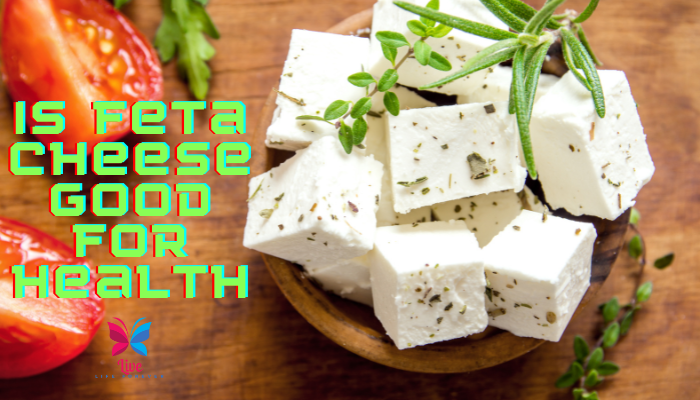Is Feta Cheese Good For Health? The Nutrition, Benefits and Risks

Is Feta Cheese Good For You? The Nutrition, Benefits and Risks

Is Feta Cheese Good For Health
Cheese lovers rejoice! Feta provides flavor galore along with substantial nutritional components showing promising benefits for heart health, digestion, bones and beyond according to emerging research . But concerns over salt content or impact on weight or cholesterol levels leave many wondering – is feta ultimately good or bad for health? This definitive guide dives into the science-based pros and cons of feta cheese nutrition.
What Makes Up Feta Cheese?
Traditional feta cheese hails from Greece and contains a crumbly, salty and tangy white texture recognizable in Mediterranean salads everywhere. Authentic feta acquires unique qualities from production methods passed down over centuries :
- Made from sheep milk (up to 70-80%), or a sheep/goat blend
- Aged in brine baths for at least 3 months allowing signature salty flavor to develop while preserving freshness without refrigeration
- Contains live active probiotic cultures balancing digestion
- Provides high protein levels with all essential amino acids
- Offers a rich source of bio available calcium unavailable in most other foods
These traditional feta cheese properties provide a powerful package of vitamins, minerals and probiotics explaining unique health advantages that mass produced feta styles may lack. Understanding what gives authentic feta its nutrition edge helps maximize benefits.
Feta Cheese Nutrition Facts
One ounce (around 4 cubes measuring 1/2 inch) of feta cheese provides (3):
- 75 calories
- 4 grams protein
- 6 grams fat
- Less than 1 gram carbohydrates
- 10% RDI calcium
- 8% RDI phosphorus
- 6% RDI riboflavin
- 4% RDI vitamin B12
Full fat feta from sheep or goat milk also contains high levels of bioavailable calcium and conjugated linoleic acid unavailable from other food sources, along with healthy medium chain fatty acids and fat soluble vitamins A, D3, E and K2.
These properties provide immunity defense through cold seasons, benefit cardiovascular function and metabolic health markers when consumed moderately as part of balanced dietary patterns .
Top 7 Science-Backed Benefits of Feta Cheese
Delving deeper into the research around feta cheese benefits turns up promising advantages for multiple aspects of wellness. Here are seven top research-backed ways feta boosts health:
1. Rich source of bone-building calcium and phosphorus
Dairy products reign as a leading dietary calcium provider critical for bone mineral density at all life stages. Feta cheese delivers 151 mg calcium per ounce – similar to cheddar or mozzarella via a more easily absorbed format. Whey calcium in aged cheeses demonstrates superior bioavailability and retention compared to plant-based calcium sources . This makes just 1-2 ounces of crumbled feta a simple way to meet calcium needs for strong bones.
2. Contains conjugated linoleic acid to boost fat burning
Grass fed sheep and goat milk offers higher levels of a unique fatty acid called CLA (conjugated linoleic acid) that research reveals can accelerate fat burning, enhance lean muscle mass and reduce body fat especially around the midsection when eaten regularly (6). CLA both limits fat storage while improving fat breakdown. This gives feta cheese an advantage over cheeses from grain fed cattle.
3. Loaded with vitamin B2 to support energy levels
Riboflavin (vitamin B2) plays a key role energy metabolism, converting nutrients into cellular fuel. B2 also acts as an antioxidant protecting cells from damage. Just a 1-2 ounce feta serving meets around 20% of daily B2 needs promoting consistent energy supplies, thriving metabolism, healthy vision and glowing skin .
4. Contains vitamin B12 for mood and memory
Another B vitamin, cobalamin (vitamin B12) often runs low in modern diets due to soil depletion issues. B12 is essential for neurological function, DNA synthesis, eye health and preventing anemia. With 2.5mcg vitamin B12 per ounce, feta cheese helps vegetarians meet intake needs for cognitive support as people age .
5. Probiotic content and CLA benefit digestive health
Traditional feta production methods relying on active brine cultures generates significant levels of probiotics like Lactobacillus. These healthy gut bacteria aid digestion by fighting inflammation, enhancing nutrient assimilation and protecting from stomach issues like ulcerative colitis according to studies . The CLA content also demonstrates prebiotic properties feeding good gut flora. Talk about good mood food!
6. Anti-inflammatory action protects cardiovascular function
Aged goat and ewe milk cheeses like feta contain anti-inflammatory molecules that mitigate systemic inflammation involved in coronary artery disease development . This inflammatory regulation paired with feta’s ability to raise good HDL cholesterol gives protection against cardiovascular complications.
7. High in Vitamin K2 to prevent calcification of arteries
Feta made from sheep or goat milk serves up a whopping 15-30 mcg of Vitamin K2 per ounce. Vitamin K2 clears calcium out of blood vessels preventing dangerous plaque buildup and risk of heart attack or stroke while allowing calcium deposit in bones where it supports health . Although this benefit remains understudied relative to feta specifically, full fat cheeses are one of the best dietary sources of K2 generally.
Assessing Potential Health Risks
Most nutrition authorities consider cheese perfectly healthy when enjoyed in proper portions as part of an overall balanced diet . Some specific considerations come into play when assessing how much feta cheese supports versus undermines wellness:
Salt Content The brining process gives feta its distinctive tang but also drives up salt content. A 1.5 ounce serving provides around 15% the tolerable upper limit for sodium intake for adults set by heart organizations . While this reasonably fits into a 2000 mg/day sodium budget, those with hypertension or kidney issues need extra caution with salty cheeses.
Milk Allergies Sheep and goat milk proteins trigger reactions in a small subset of adults and children with dairy sensitivities. Notice symptoms like congestion, gas, abdominal discomfort or skin irritation flaring after eating feta to determine personal tolerance. Most do fine with sheep or goat cheese but pay attention to body feedback.
Pregnancy The CDC advises avoiding all soft, semi-soft and processed cheeses during pregnancy whether made from pasteurized or raw milk due to small risk of pathogenic bacteria leading to fetal infection . This includes feta cheese made the traditional way. Pasteurized feta likely presents minimal if any risk but check with your OBGYN.
Weight Gain While the high protein and CLA content provide weight management benefits, the high saturated fat and calorie load can tip scales when eaten in excess. Keep portions around 1-2 ounces as part of vegetable dishes or salads rather than treating it as a daily snack. Combining with vegetable carbs helps mitigate fat intake compared to eating solo.
Assuming good digestive tolerance, feta cheese as part of an overall high produce, plant-slanted Mediterranean style diet pattern aligns with long term disease prevention and longevity considering findings from major nutrition studies .
Healthy Ways To Enjoy Feta Cheese
Luckily this Mediterranean staple shines through in recipes beyond plain crumbled salad toppers. Try feta in these flavorful, waistline-friendly dishes:
Greek omelets – Whip 2 eggs with a splash of milk, fresh herbs of choice and spinach. Pour into hot oiled pan, cook halfway through then sprinkle crumbled feta and olives over one side. Fold omelet over filling before sliding onto plate.
Mediterranean pizza – Top premade pizza crust with tomato sauce, spinach, diced red onion, olives, shrimp, lemon zest, goat cheese and feta. Bake until hot and bubbly.
Feta cream dip – Blend 4 ounces softened cream cheese, 1/3 cup Greek yogurt, 1⁄4 cup each crumbled feta and milk, 2 minced garlic cloves, lemon juice and fresh dill or chives.Pair with fresh veggies or pita chips.
Watermelon feta salad – Toss bite sized watermelon chunks, cucumber slices and red onion rings with mint, lemon zest, olive oil, salt and pepper. Top with crumbled feta before serving.
Chicken stuffed peppers – Roast red bell peppers until softened. Stuff with lean ground chicken or turkey seasoned with cumin, garlic and chili powder topped with crumbled feta then bake to heat through.
Adding a feta crumble on top of roasted veggies, mixed into omelets or egg bakes, inside chicken cutlets, or as the protein component to balance grains like quinoa, farro or brown rice bowls all work deliciously!
The Greeks clearly knew what they were doing making this versatile cheese a dietary staple. With so many innovative ways to enjoy feta and substantial nutritional payoff, the pros seem to outweigh potential cons for most people.
Frequently Asked Questions About Feta Cheese
Still have lingering questions about how feta cheese impacts health? Here are evidence-based answers to the most common queries.
Q: Is eating feta cheese every day bad for health because of the salt content?
A: Eating a couple ounces of feta cheese daily can fit into a healthy, well balanced diet for most people without issue. While the sodium content seems high compared to other cheeses, the American Heart Association recommends ideal limits at around 2300mg sodium per day, allowing plenty of room for flavor enhancers like feta without health risks when focus remains on whole foods (16). Those with specific cardiovascular or kidney related conditions would benefit keeping feta intake to a few times weekly versus daily though. Monitoring blood pressure and fluid retention signs allows tailoring intake levels appropriately.
Q: Does feta cheese raise cholesterol levels or increase heart disease risk?
A: Based on a body of evidence around cheese consumption patterns, eating moderate amounts of feta cheese does not appear to negatively impact cholesterol profiles or heart disease likelihood the way sugars, processed carbs or trans fats might. Some studies actually associate eating full fat cheeses like feta regularly with better cholesterol ratios and lowered coronary artery disease occurrence thanks to anti-inflammatory fatty acids they contain . Of course diet quality as a whole remains most influential – pairing feta with processed crackers, charcuterie meats and sugary foods loses these benefits quickly. But used to top salads, omelets or whole grain bowls, feta appears protective for most.
Q: Can feta assist with fat loss goals or is it too high in calories and fat?
A: Early evidence indicates feta can actually mildly assist fat burning thanks to its conjugated linoleic acid content. CLA is uniquely high in cheeses from grass fed sheep and goat milk. Studies show supplemental CLA slightly accelerates fat loss and lean tissue gains especially around the abdomen when paired with exercise (18). Two ounces of feta provides around 0.15 grams CLA falling quite short of doses used in trials, but some mild metabolism boosting benefits emerge eating moderate feta amounts. Ultimately though, managing overall calorie intake remains key for weight management. Feta eaten within daily calorie targets contributes protein, bioavailable calcium and anti-inflammatory qualities without undermining body composition like many fat sources.
Q: Is raw feta cheese safe or only pasteurized?
A: According to CDC guidance, all raw milk cheeses carry some degree of risk for bacterial contamination that could lead to serious foodborne infection . Pregnant women in particular should stick to pasteurized cheese options eliminating any questionable food safety issues. For the general public, pasteurized feta poses very minimal if any hazards while providing the same nutritional benefits. Well produced raw feta from small artisanal farms utilizing tested sheep/goat milk may prove safe for most people when aged over 60 days allowing protective probiotics to develop, but some risk always exists eating unpasteurized products. Check with your doctor given personal digestive health status and immunity considerations to decide if raw feta suits your situation.
Q: What kind of milk should feta cheese come from – sheep, goat or cow?
A: Traditional Greek feta cheese production calls for using 70-30% sheep milk blended with some goat milk which offers highest nutrition levels. Sheep and goat milk lack A1 casein proteins that cause digestive irritation for some people sensitive to cows milk products. Their milk also provides more medium chain fatty acids and conjugated linoleic acid beneficial for metabolic and cardiovascular health. The caveat is that authentic sheep/goat milk feta costs substantially more than mass produced cow varieties. But spending up for premium feta ensures the classic texture, tangy flavor and nutritional superiority traditionalists seek. Cow milk feta lacks the same probiotic content and weight management bonuses but costs less while still delivering ample calcium making it reasonable choice still.
The Bottom Line on Is Feta Cheese Good For Health
Reveling in the sharp, crumbly goodness of traditional feta cheese poses little downside for most people when incorporated as part of an overall high produce dietary pattern. Compelling indicators actually suggest feta benefits long term wellness by defending against chronic inflammation underlying most diseases. Any food can become problematic if overeaten, but enjoying feta cheese in moderation alongside antioxidant packed Mediterranean style cuisine fills flavor cravings while optimizing nutrition all around.




